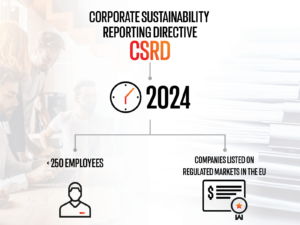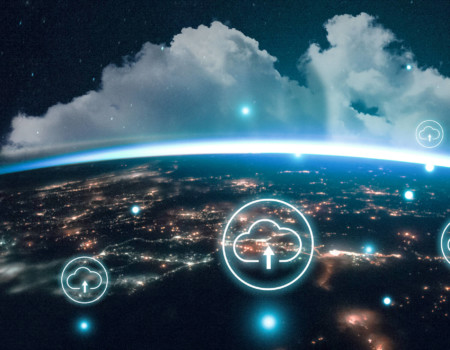Aligning operations with the current and upcoming regulations will soon be a concern for every organization. Complying with the EU’s recommendations is a way to enhance a company’s image as a socially responsible business, not just to avoid unpleasant financial consequences. We present examples of how IT solutions can help companies comply with the standards.
What is a carbon footprint?
A carbon footprint is defined as the total amount of greenhouse gas emissions produced by a specific person, organization, event, or product life cycle. This category includes emissions of such gases as: carbon dioxide, methane, nitrous oxide, sulfur hexafluoride, and other greenhouse gases. All of these compounds have been described as extremely harmful to the natural environment. Their impact and excessive production are considered one of the greatest destructive factors for the climate.
Carbon footprint – legal regulations
The requirement to significantly reduce the carbon footprint of organizations has become a reality. In connection with the proposal of the Corporate Sustainability Reporting Directive (CSRD), adopted by the European Commission in 2021, companies operating in the European Union are facing a serious challenge. It requires public and private companies to report on ESG (Environmental, Social and Corporate Governance), which are non-financial factors primarily related to the areas of environmental protection, social responsibility, and corporate governance. The new directive is expected to come into force in 2024 and will apply to companies employing over 250 employees as well as those listed on regulated markets in the EU (excluding micro-enterprises for the time being). Over time, the directive is expected to apply to even more companies, including those with more than 10 employees.
The new EU regulations aim to mobilize companies to introduce policies and practices that benefit the environment. Their job is to monitor, through reports, the amount of CO2 an organization produces, the amount of waste it generates, or any environmental initiatives it has undertaken. This presents a potential challenge in preparing company IT systems to report on the CO2 produced, take operational measures to reduce the carbon footprint, and monitor progress toward these goals.

CO2 emissions in IT
It is a well-known fact that the heat and power industry, huge factories, and processing plants generate significant amounts of CO2. However, little is still said about the fact that non-manufacturing operations also leave a huge carbon footprint, including IT.
IT activity is impossible without the use of electronic and mobile devices, the Internet, and – consequently – electricity. Annually, power plants around the world emit approximately 10 billion tons of carbon dioxide. Databases alone consume 2-3% of the world’s energy needs. The COVID-19 pandemic has definitely increased these statistics. Data storage is not the only source of CO2 in the IT industry. Another one is the production of equipment used in this sector. It is impossible to balance when the recycling of electrical devices is negligible in comparison to the amount of e-waste generated. According to a report by Statista, approximately 50 million tons of e-waste has been recorded worldwide. Compared to 2014, this is an increase of 16.4%. This number continues to grow. The vast majority of companies, as many as 89%, recycle less than 10% of their work-related electronic devices.
The failure of IT companies to reduce their carbon footprint is not due to a lack of ambition on the part of their employees. It is a more complex problem, often resulting from a lack of alternatives to proven work tools or a lack of awareness of these alternatives.

How can companies better manage excess CO2 production?
There are many ways to reduce energy consumption in a company. In addition to greening product packaging, optimizing delivery methods, and choosing electric delivery vehicles, companies are also looking for global IT solutions to support their efforts aimed at carbon footprint reduction.
Low-carbon beginnings
In order to more accurately control the amount of CO2 produced by a company, it is also important to analyze the pre-production stages of a product/service/application. The carbon footprint consists not only of the amount of energy used during production, but also during testing. This is very important and helps companies create a sustainable production environment. Business intelligence tools that generate advanced reports for monitoring a company’s production and CO2 emissions, such as SAP PaPM, as well as predictive tools equipped with “what-if” analysis, come to the rescue.
Low-emission document circulation
Implementing IT solutions that eliminate the use of paper forms is a way not only to speed up and automate operational activities, but also to improve the environmental standards of a company. In the case of Hicron’s clients, they are most often used in the invoice circulation process: an invoice issued electronically can be automatically accepted if the number on the invoice matches the reference number of an order which was previously accepted by authorized persons. We can avoid double approvals of similar documents, saving the time spent on administrative activities.
A less obvious example is the replacement of paper forms used in the process of accepting a vehicle for maintenance at one of Hicron’s clients in Switzerland – a vehicle importer and dealer. All information about the vehicle, damages, and repairs is stored on a mobile device that communicates with a central SAP system, eliminating the need to waste time filling out forms and then manually entering them into the system. What is more, the application – equipped with an additional module – reminds the customer about any potential maintenance activities for a given vehicle model, promotions, and special offers.
Cloud as an alternative
The use of advanced, state-of-the-art technologies supports companies in green transformation. Local servers consume significantly more power. A good solution to this problem is to move your local infrastructure to the cloud. It provides practically unlimited data storage capabilities. As a result, it is more easily accessible, which reduces the amount of work spent on finding the necessary information, and thus – decreases energy consumption. In addition, companies providing access to their clouds have ultra-modern infrastructures equipped with energy-saving mechanisms. Such advanced systems limiting CO2 emissions in data transmission are practically impossible to create in local infrastructures.

Reducing the carbon footprint with SAP S/4HANA
Moving local infrastructure to a cloud environment opens up countless opportunities for an organization. Thanks to ultra-modern, synchronized, and optimized systems, cloud solutions not only increase the convenience of working with data, but also guarantee the most sustainable data storage environment. The RISE with SAP concept provides the applications, platforms, tools, and services needed to grow a business, advance innovation, maximize automation, and simplify network connections. It makes it possible to create a cloud environment that guarantees transparency and maximum ease of access to data.
Moving local infrastructure to the SAP S/4HANA cloud lets organizations do more than just create an efficient, intelligent, and automated space. It is also a secure and efficient environment that supports company sustainability by offering, among other things, tools to control and transparently report all emissions. With the cloud, it is possible not only to optimize an organization’s processes and streamline its work, but also to substantially reduce its carbon footprint.
Healthier environment, Customer trust, and employee safety
Choosing to reduce your carbon footprint is also a way to build Customer trust. Officially sharing information about reducing carbon emissions, recycling used equipment, replacing it with recycled appliances, using green transportation, making deliveries in the most sustainable way – all such activities are worth continuing and promoting, as they are positively perceived by those around us. In accordance with the trends of corporate social responsibility, pro-environmental activities reduce customer attrition and help companies maintain a positive image. By sharing information with their audiences about the carbon dioxide they produce, but also any efforts they are making to reduce it or improve the state of the environment, companies build their overall image as responsible, committed, and trustworthy. A company’s commitment to green transformation helps strengthen customer satisfaction and brand loyalty.
Companies that are committed to green transformation are also relatively more attractive places to work. They help employees find deeper meaning in their work, which keeps them engaged longer and supports their professional development, as well as the development of the company itself.







